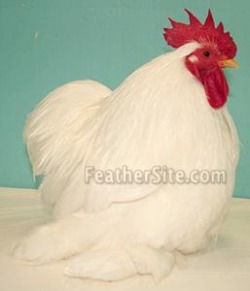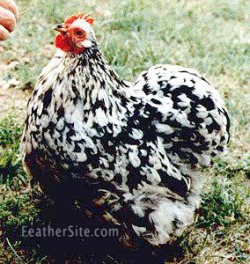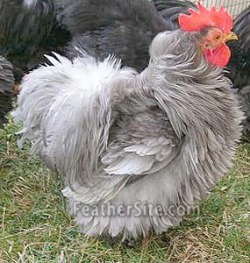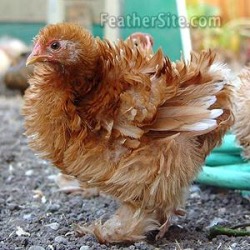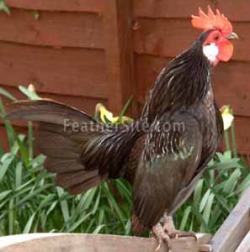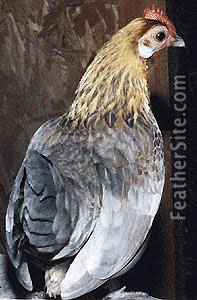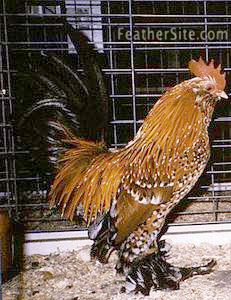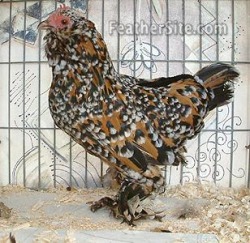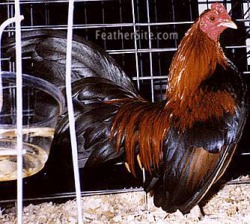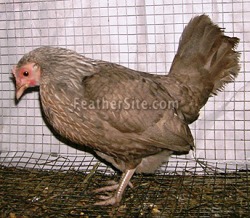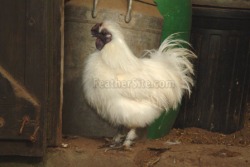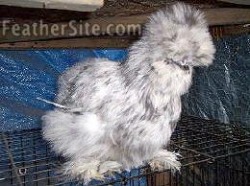T.C. Hatchery
Cochins
~Current amount: 1 mottled chick
1 white pullet
1 partridge rooster
1 white pullet
1 partridge rooster
Bantam Cochins are known as Pekins in Britain and Australia.
These little birds are very popular both in the fancy for showing and with backyarders as pets. They are very tame and pretty. They are also popular as broody hens, being able to cover a fair number of eggs and sitting very tightly.
If you want to learn more, there's a new book: The Australian Pekin Bantam: The Complete Handbook and Standards for the Pekin Bantams, available from the Pekin Bantam Club of Australia, c/o Keith Dubber, PO Box 1503, Armidale 2350 NSW, Australia, phone: +61 2 6775 1315. It includes history of the breed, breeding, and colors (with both color and B&W photos of all the varieties).
These little birds are very popular both in the fancy for showing and with backyarders as pets. They are very tame and pretty. They are also popular as broody hens, being able to cover a fair number of eggs and sitting very tightly.
If you want to learn more, there's a new book: The Australian Pekin Bantam: The Complete Handbook and Standards for the Pekin Bantams, available from the Pekin Bantam Club of Australia, c/o Keith Dubber, PO Box 1503, Armidale 2350 NSW, Australia, phone: +61 2 6775 1315. It includes history of the breed, breeding, and colors (with both color and B&W photos of all the varieties).
Cochin Frizzles
~Current amount: 3 black chicks
1 white chick
1 red chick
1 white chick
1 red chick
Frizzle is a mutant in the chicken in which the feathers grow so that they curve outward, instead of lying smoothly along the bird's body. It can occur in many breeds.
Here's Glenda Heywood's article on What Makes a Good Frizzle?
Here's Glenda Heywood's article on What Makes a Good Frizzle?
Dutch Bantam
~Current amount: 3 chicks
The Dutch bantam is a very old breed. It was kept by peasants to provide them with small eggs, as the law stated that all large eggs were to go to the Lord of the Manor.
These are among the smallest bantams: cocks weigh 21 oz., hens 19 oz., cockerels 20 oz. and pullets 18 oz.
These are among the smallest bantams: cocks weigh 21 oz., hens 19 oz., cockerels 20 oz. and pullets 18 oz.
Milli Fleur d'Uccle Bantam
~Current amount: 2 chicks [a pair]
One of the Belgian true bantams (meaning there is no standard-sized form), the bearded and booted Mille Fleur d'Uccle is one of the prettiest of fowl. The d'Uccles also occur in other color varieties, such as Porcelain, Black Mottled, Self Blue (self means solidly one color), and Blue Mille Fleur. They are single combed birds and the standard calls for vulture hocks, a disqualification in most breeds. (Vulture hocks are long stiff feathers protruding down and back from the hock joint. These can be better seen on my image of a Sultan male.)
The Mille Fleur pattern consists of a ground color of mahogany, with each feather marked with a crescent shaped bar of black and tipped with a V-shaped white spangle. The true coloring does not usually appear until the first adult molt. The Porcelains are patterned the same way, but the ground color is straw, and the barring blue with a white tip.
I found these birds to be so tame that it was often a problem to keep them from flying up on me when I didn't want to be wearing a few chickens! If I could only keep one breed of bantams, it would be these guys.
You might also want to visit my page on the closely related Sabelpoot bantam (I really don't understand the relationships among these small European booted, bearded and booted, and clean legged bantams). As far as I can tell, d'Uccles are bearded and Booted bantams are Nonbearded (but don't quote me on that!)
The Mille Fleur pattern consists of a ground color of mahogany, with each feather marked with a crescent shaped bar of black and tipped with a V-shaped white spangle. The true coloring does not usually appear until the first adult molt. The Porcelains are patterned the same way, but the ground color is straw, and the barring blue with a white tip.
I found these birds to be so tame that it was often a problem to keep them from flying up on me when I didn't want to be wearing a few chickens! If I could only keep one breed of bantams, it would be these guys.
You might also want to visit my page on the closely related Sabelpoot bantam (I really don't understand the relationships among these small European booted, bearded and booted, and clean legged bantams). As far as I can tell, d'Uccles are bearded and Booted bantams are Nonbearded (but don't quote me on that!)
Old English Game Birds [OEGB]
~Current amount: None
For lots of images of the different varieties of this breed, stop by the pages of the Northwest Old English Game Bantam Club.
If you are involved with these birds, here's a book you really should know about:
Old English Game Bantams as Bred and Shown in the United States by F. P. Jeffrey and William Richardson, 1995 (126 pp., Old English Game Bantam Club of America, 316 Sullivan Rd., Simpsonville, SC 29680, 864-299-0901, e-mail: [email protected]). If you are breeding or showing OEG bantams, this book is a must! Chapters discuss their history, standards, judging, conditioning, principles of breeding and genetics of OEG bantams, and all the various color varieties, including 48 color photos of those.
It should be noted that the body styles of US and UK OEG bantams differ noticeably. Here's a page with UK OEG bantams.
If you are involved with these birds, here's a book you really should know about:
Old English Game Bantams as Bred and Shown in the United States by F. P. Jeffrey and William Richardson, 1995 (126 pp., Old English Game Bantam Club of America, 316 Sullivan Rd., Simpsonville, SC 29680, 864-299-0901, e-mail: [email protected]). If you are breeding or showing OEG bantams, this book is a must! Chapters discuss their history, standards, judging, conditioning, principles of breeding and genetics of OEG bantams, and all the various color varieties, including 48 color photos of those.
It should be noted that the body styles of US and UK OEG bantams differ noticeably. Here's a page with UK OEG bantams.
Silkies
~Current amount: 3 white chicks
2 black chicks
2 red chicks
2 black chicks
2 red chicks
This breed was developed in the Orient, probably in Japan. The feathers don't have barbs or quills, and the birds look and feel like Persian cats! Some of the varieties are Black, Blue, Buff, Partridge, Silver-grey and White. Interesting characteristics of the breed are its 5 toes and black skin. They also have walnut combs, which should be a deep mulberry approaching black. Red comb and wattles are disqualifications. Silkie hens are among the best to use as broodies if you want to hatch your eggs out under hens. They make wonderful mothers and I've known a silkie rooster to steal a brood of very young chicks and raise them himself -- this is a very nurturing breed!
All bird info is from http://www.feathersite.com
